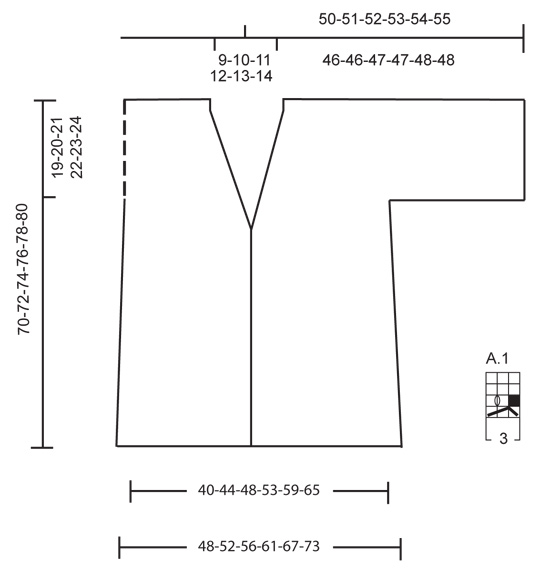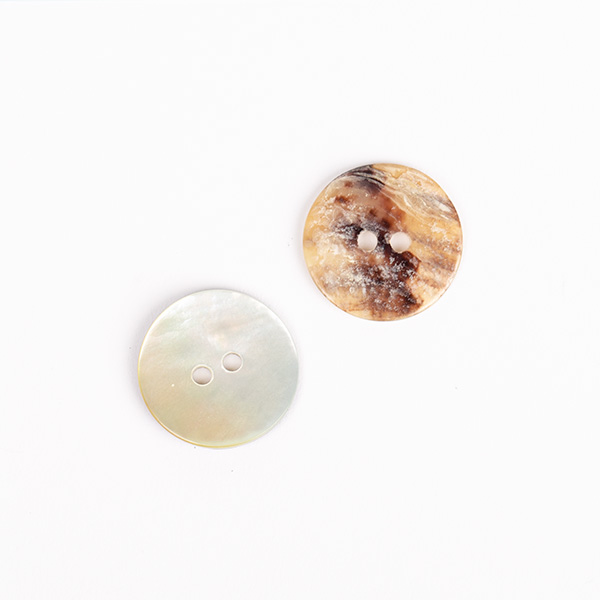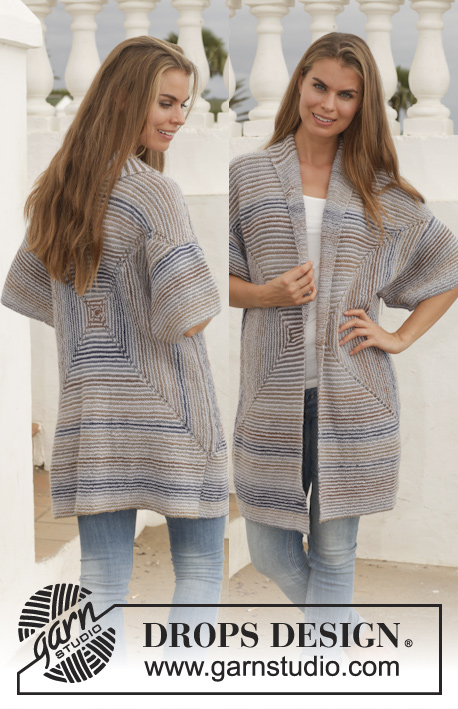Comments / Questions (44)
![]() NZINA wrote:
NZINA wrote:
Bonjour je suis vraiment désolée je vous ai donné des chiffres pour le devant droit. Pardon. Je tricote le modèle en plus grande taille qui est XXXL. Ma question se pose pour le demi devant droit. Merci.
04.08.2022 - 10:59DROPS Design answered:
Bonjour Mme Nzina, pas de souci, voici donc pour la taille XXXL: vous montez 74 mailles, diminuez 7 mailles sur le côté + 19 mailles pour l'encolure et montez 34 mailles pour la manche: 74-7-19+34= 82 mailles. Vous rabattez 74 mailles = il reste 8 mailles. Est-ce plus clair ainsi? Bon tricot!
04.08.2022 - 12:34
![]() NZINA wrote:
NZINA wrote:
Bonjour je monte 74 m pour le dos. Je diminue 7 m de chaque côté = 74-14=60 m. Si 60 m/2 = 30 m pour chaque côté. Donc 30 m-19 = 11 m. Je monte 34 m pour la manche = 11 m + 34 m =45 m. Là on est loin des 82 m ( 82- 8 =74 m) c'est à dire 74 m pour l'épaule et la manche et 8 m de bordure encolure dos. Où se trouve l'erreur ? Merci pour votre réponse. Bonne journée.
03.08.2022 - 17:09DROPS Design answered:
Bonjour Mme Nzina, vous devez monter 82 mailles au minimum pour la 1ère taille pour commencer le dos - vous diminuez ensuite 7 m x 2 = 14 m au total => il reste 68 mailles, vous montez 2 x 46 mailles pour les manches soit: 68+46+46=160 mailles. Vous rabattez lez 12 m centrales = il reste 74 mailles pour chaque épaule/manche et vous diminuez 1 maille côté encolure = il reste 73 mailles pour l'épaule/manche. Tricotez-vous une autre taille? Je ne retrouve pas tous vos nombres dans le modèle.
03.08.2022 - 17:18
![]() NZINA wrote:
NZINA wrote:
Bonjour le problème est que j'ai moins de mailles sur le dos après les diminutions. Dois-je diminuer une seule fois 1 maille à 8 mailles point mousse pour l'encolure dos ou bien 8 fois et de toutes les façons ça ne tombe pas juste. J'ai défait trois fois et recommencé et je bloque. J'ai besoin de votre aide. Merci
02.08.2022 - 12:39DROPS Design answered:
Bonjour Mme Nzina, pourquoi avez-vous moins de mailles? Avez-vous diminué trop de mailles? Vous commencez avec 82-87-93-101-111-123 m et diminuez 8 fois 1 m de chaque côté = soit 16 m au total - vous montez ensuite 46-45-44-41-38-34 m de chaque côté, rabattez les 12-13-15-17-19-21 m centrales pour l'encolure puis diminuez 1 m pour l'encolure, il doit vous rester 73-74-75-75-76-77 m pour chacune des épaules/manches du dos. Est-ce que ceci peut vous aider?
02.08.2022 - 13:17
![]() NZINA wrote:
NZINA wrote:
Bonsoir après avoir effectué toutes les diminutions de dos et devant il me reste plus de mailles sur le devant. Je ne comprends pas. J'ai besoin de votre aide. Merci.
01.08.2022 - 19:27DROPS Design answered:
Bonjour Nzina, vous montez 54-56-59-63-68-74 m et diminuez 7 mailles sur le côté, puis vous diminuez 14-14-15-16-17-19 m pour l'encolure et vous montez 46-45-44-41-38-34 m pour la manche, vous avez maintenant 79-80-81-81-82-82 m, rabattez les 71-72-73-73-74-74 m pour l'épaule/manche, il reste 8 m. En espérant que ce décompte puisse vous aider. Bon tricot!
02.08.2022 - 08:54
![]() Alena wrote:
Alena wrote:
Dobrý večer, paní Hano, děkuji Vám za vysvětlení a za video! je to opravdu snadné.\r\nS pozdravem a přáním pěkného večera, Alena.
18.04.2021 - 20:21
![]() Alena wrote:
Alena wrote:
Dobrý večer, mohla byste mi poradit, jak se pletou copánky na tomto modelu? Je tu popis jen vzoru A1... Děkuji Vám za pomoc, s pozdravem Alena.
16.04.2021 - 21:31DROPS Design answered:
Dobrý den, Aleno! Copánky na tomto modelu jsou snadné, tzv. falešné a nepotřebují klasické křížení za pomoci copánkové jehlice - vytváří se jednoduchým nahazováním a přetahováním ok. Vzor A1 na ně tedy úplně stačí. Podívejte se na video-ukázku zde - je to opravdu hračka :-) Hodně zdaru! Hana
18.04.2021 - 11:48
![]() Natalia wrote:
Natalia wrote:
Hallo, mir ist nicht ganz klar, ob das Diagramm nur Hinreihen zeigt oder sind die Reihen 2 und 4 (auf dem Diagramm) Rückreihen?
07.04.2020 - 22:40DROPS Design answered:
Liebe Natalia, alle Reihen sind im Diagram gezeigt, dh die Hin- sowie die Rückreihen - mehr über Diagramme lesen Sie hier. Viel Spaß beim stricken!
09.04.2020 - 16:05
![]() Birgit wrote:
Birgit wrote:
Die Abnahmen an den Seiten werden in einer Hinreihe - hier sind linke Maschen mit rechten Maschen gemacht?
30.12.2018 - 15:24DROPS Design answered:
Liebe Birgit, unser DesignTeam wird das Abnahme-Tipp mal prüfen, ich würde also 2 M links zusammen stricken (= bei den Hinreihen). Viel Spaß beim stricken!
02.01.2019 - 10:55
![]() Jane wrote:
Jane wrote:
Is the back piece meant to be narrower than the front pieces? Even allowing for 8 stitches for the band, the front pieces together are made up of 46 + 46 = 92 (in the smallest size) but the back piece has only 82 stitches.
08.08.2015 - 14:36DROPS Design answered:
Dear Jane, Yes, this jacket is meant to be loose. Happy knitting!
18.12.2015 - 12:02
![]() Iliane wrote:
Iliane wrote:
Hallo, kann ich die Jacke auch mit 2 Fäden Alpaca stricken? Danke für die Antwort!
09.09.2014 - 17:48DROPS Design answered:
Liebe Iliane, das geht leider nicht. Um die Stärke C zu erreichen bräuchten Sie 2 weitere Fäden Alpaca, also insgesamt 3 Fäden Alpaca (Garngruppe A + C).
09.09.2014 - 19:42
Letizia#letiziacadigan |
|||||||||||||
|
|
|||||||||||||
Knitted DROPS jacket with cables in "Alpaca" and "Alpaca Silk" or "Vivaldi". Size: S - XXXL.
DROPS 153-16 |
|||||||||||||
|
GARTER ST (back and forth on needle): K all rows. 1 ridge = K2 rows. PATTERN: See diagram A.1. The diagram shows all rows in pattern seen from RS. DECREASE TIP: Dec inside 1 edge st. All dec are done from RS! Dec before 1 edge st as follows: K 2 tog. Dec after 1 edge st as follows: Slip 1 st as if to K, K 1, psso. BUTTONHOLES: Dec for buttonholes on right band. 1 buttonhole = K tog fourth and fifth st from edge and make 1 YO. Dec for buttonholes when piece measures: SIZE S: 36 and 43 cm / 14¼" and 17". SIZE M: 37 and 44 cm / 14½" and 17¼". SIZE L: 38 and 45 cm / 15" and 17¾". SIZE XL: 39 and 46 cm / 15¼" and 18". SIZE XXL: 40 and 47 cm / 15¾" and 18½". SIZE XXXL: 41 and 48 cm / 16⅛" and 19". ---------------------------------------------------------- BACK PIECE: Worked back and forth on circular needle. Cast on 82-87-93-101-111-123 sts (includes 1 edge st in each side) on circular needle size 4.5 mm / US 7 with 1 strand Alpaca + 1 strand Alpaca Silk (= 2 strands). P 1 row from WS. Then work next row as follows: 1 edge st, P 11-11-11-12-11-11, * A.1 (= 3 sts), P 8-9-8-9-9-9 * repeat from *-* 5-5-6-6-7-8 times in total, A.1, finish with P 11-11-11-12-11-11 and 1 edge st. Continue this pattern AT THE SAME TIME when piece measures 5 cm / 2", dec 1 st in each side every 6-6-6-6½-6½-6½ cm / 2⅜"-2⅜"-2⅜"-2½"-2½"-2½" 7 times in total = 68-73-79-87-97-109 sts. When piece measures 51-52-53-54-55-56 cm / 20"-20½"-21"-21¼"-21⅝"-22", cast on 46-45-44-41-38-34 new sts at the end of the next 2 rows = 160-163-167-169-173-177 sts. Then work as follows from RS: 5 sts in garter st, P 2-9-0-6-2-10, * A.1, P 8-9-8-9-9-9 * repeat from *-* 13-11-14-12-13-12 times in total, A.1, finish with P 2-9-0-6-2-10 and 5 sts in garter st. Continue this pattern. When piece measures 66-68-70-72-74-76 cm / 26"-26¾"-27½"-28⅜"-29⅛"-30" / 26"-26¾"-27½"-28⅜"-29⅛"-30", work in garter st over the middle 28-29-31-33-35-37 sts, work the other sts as before. When piece measures 68-70-72-74-76-78 cm / 26¾"-27½"-28⅜"-29⅛"-30"-30¾", bind off the middle 12-13-15-17-19-21 sts for neck. Then dec 1 st inside 8 sts in garter st on next row towards the neck = 73-74-75-75-76-77 sts remain on each shoulder/sleeve. Bind off when piece measures 70-72-74-76-78-80 cm / 27½"-28⅜"-29⅛"-30"-30¾"-31½. RIGHT FRONT PIECE: Cast on 54-56-59-63-68-74 sts (includes 1 edge st in the side) on circular needle size 4.5 mm / US 7 with 1 strand of each yarn (= 2 strands). P 1 row from WS. Then work next row as follows: 8 band sts in garter st, K 1, P 3, K 1, P 4-4-9-10-4-10, * A.1 (= 3 sts), P 8-9-8-9-9-9 * repeat from *-* 2-2-2-2-3-3 times in total, A.1, finish with P 11-11-11-12-11-11 and 1 edge st. Continue this pattern AT THE SAME TIME when piece measures 5 cm / 2", dec 1 st 7 times in the side as on back piece = 47-49-52-56-61-67 sts. Remember BUTTONHOLES - see explanation above. When piece measures 45-46-47-48-49-50 cm / 17¾"-18"-18½"-19"-19¼"-19¾", dec for neck inside 8 band sts in garter st, K 1, P 3, K 1: Dec 1 st by P 2 tog every 1½ cm /½" 14-14-15-16-17-19 times in total. AT THE SAME TIME when piece measures 51-52-53-54-55-56 cm / 20"-20½"-21"-21¼"-21⅝"-22", cast on 46-45-44-41-38-34 new sts for sleeve at the end of next row from RS. Then work as follows from WS: 5 sts in garter st, K 2-9-0-6-2-10, * A.1, K 8-9-8-9-9-9 * repeat from *-* 6-5-6-5-6-6 times in total, and continue with pattern, neck dec and band as before the rest of row. Continue to work like this until neck dec is done and piece measures 70-72-74-76-78-80 cm / 27½"-28⅜"-29⅛"-30"-30¾"-31½. 79-80-81-81-82-82 sts remain for shoulder/sleeve and band. On next row from WS bind off the first 71-72-73-73-74-74 sts = 8 sts in garter st remain for band. Continue in garter st back and forth until piece measures approx. 7-7-8-8-9-9 cm / 2¾"-2¾"-3⅛"-3⅛"-3½"-3½" from shoulder. Bind off. LEFT FRONT PIECE: Work as right front piece but reversed. and without dec for buttonholes. ASSEMBLY: Sew the shoulder seams. Sew sleeve and side seams in one inside 1 edge st. Sew bands tog mid back and sew it to the neck. Sew on buttons. |
|||||||||||||
Diagram explanations |
|||||||||||||
|
|||||||||||||

|
|||||||||||||
Have you finished this pattern?Tag your pictures with #dropspattern #letiziacadigan or submit them to the #dropsfan gallery. Do you need help with this pattern?You'll find 22 tutorial videos, a Comments/Questions area and more by visiting the pattern on garnstudio.com. © 1982-2025 DROPS Design A/S. We reserve all rights. This document, including all its sub-sections, has copyrights. Read more about what you can do with our patterns at the bottom of each pattern on our site. |
|||||||||||||




































































Post a comment to pattern DROPS 153-16
We would love to hear what you have to say about this pattern!
If you want to leave a question, please make sure you select the correct category in the form below, to speed up the answering process. Required fields are marked *.